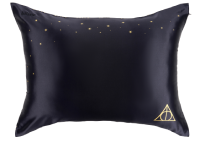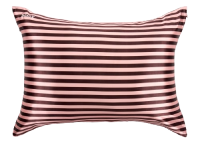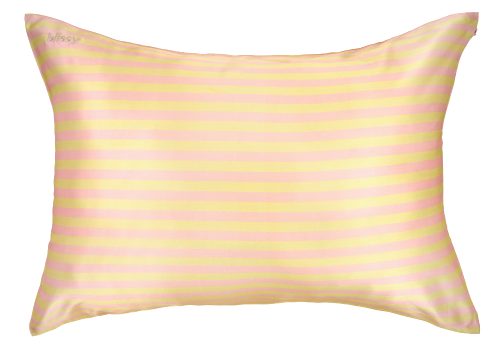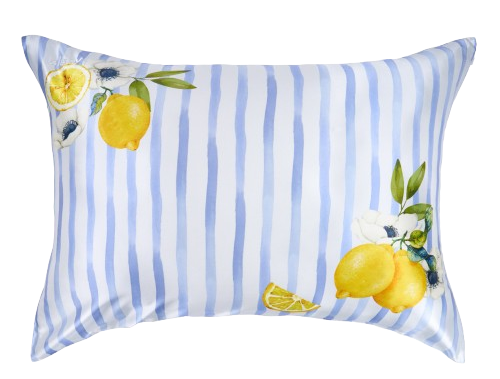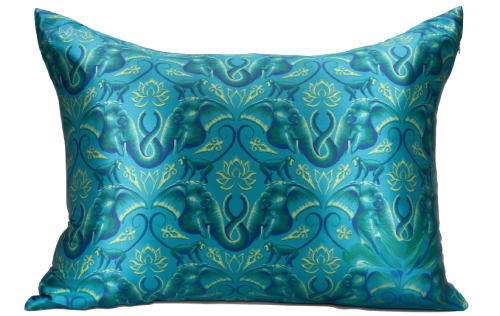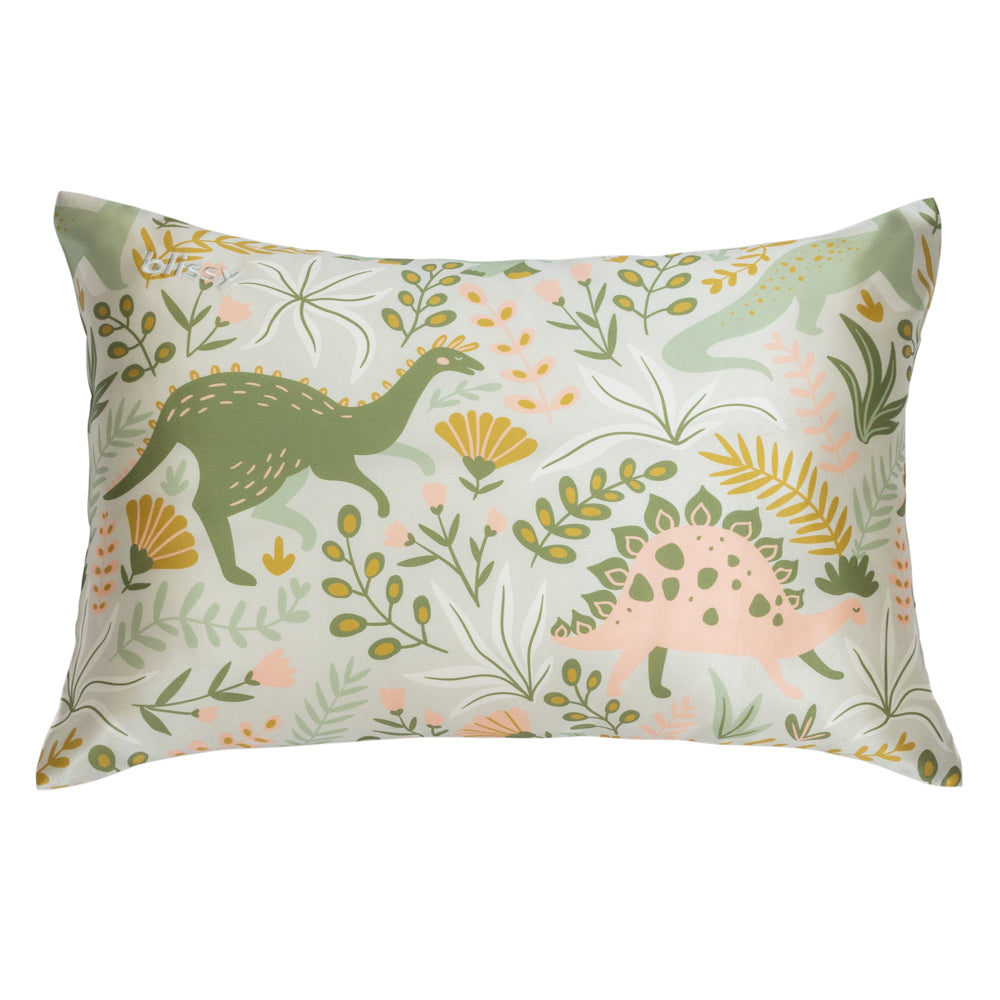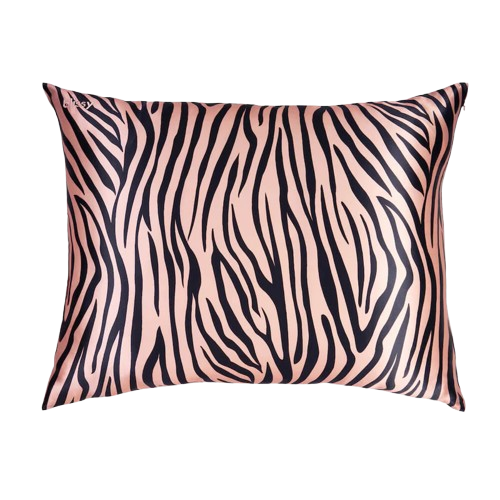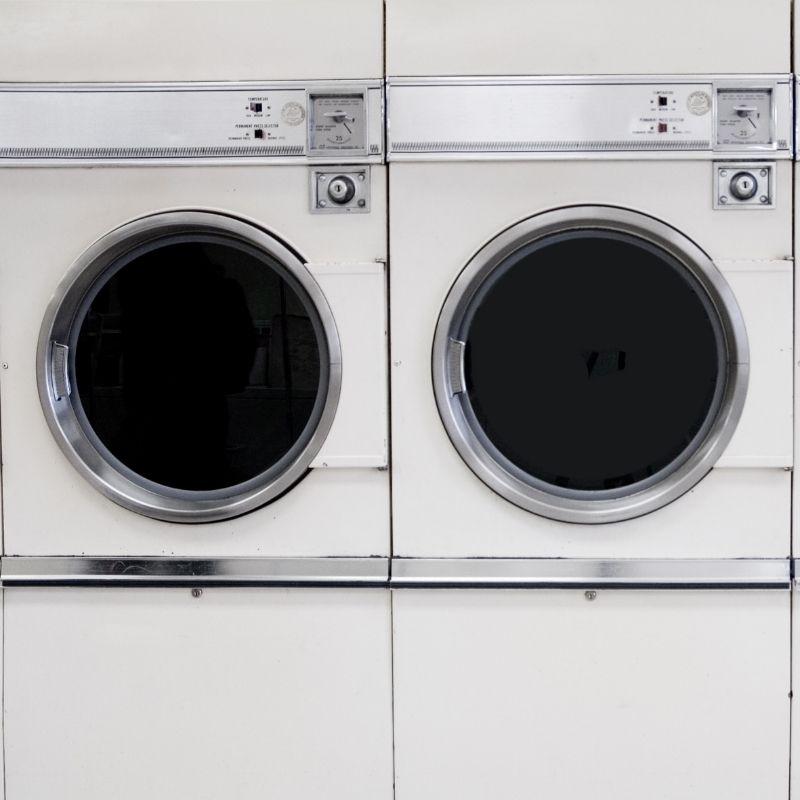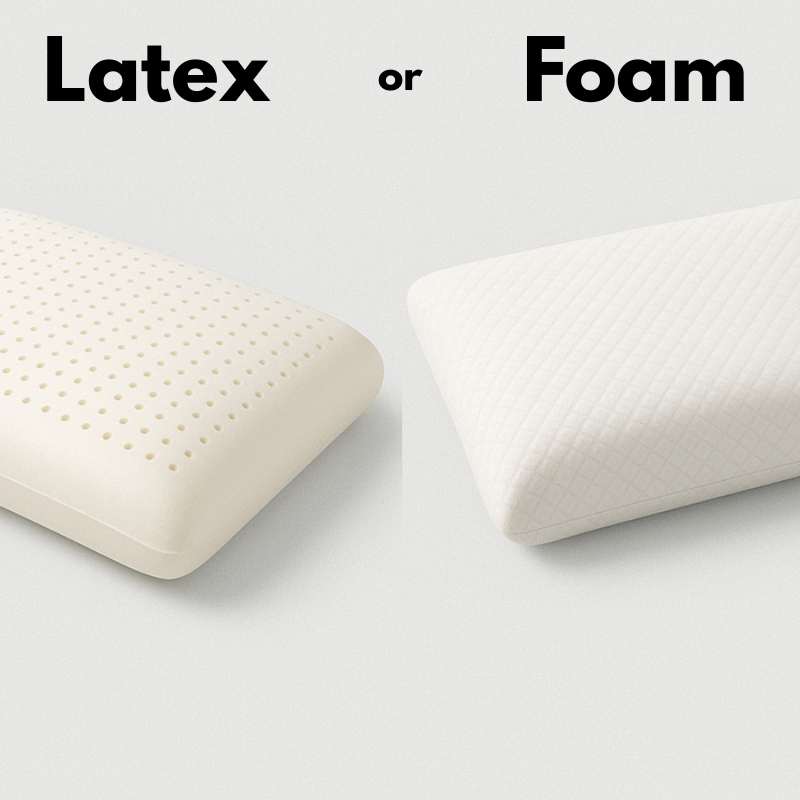Key Takeaways:
-
Sateen is cotton with a satin weave—smoother than regular cotton but less protective for hair.
-
Sateen absorbs natural oils, which may increase frizz and breakage overnight.
-
Silk outperforms sateen for all hair types, especially curly and damaged hair.
-
Silk pillowcases improved hair health for 91% of users in a clinical study.
What Is Sateen?
Sateen vs. Satin Pillowcase: Key Differences
At first glance, sateen pillowcases and satin pillowcases can seem interchangeable—but they’re not. While they share the same satin weave, they differ in what they’re made of:
-
Satin pillowcases are usually made from synthetic fabrics like polyester or rayon
-
Sateen pillowcases are woven from cotton, giving them a natural, breathable feel
-
Both offer a smooth surface and silky texture, but only silk is a natural protein fiber
Unlike silk, neither fabric provides the full benefits of a natural fiber derived from animals.
How Sateen Fabric Is Made
Sateen fabric uses a four-over-one satin weave, which means more threads are exposed on the surface. This gives the fabric its signature subtle sheen and luxurious feel. Most sateen sheets are made from long-staple cotton, creating a tight weave that’s softer than standard cotton pillowcases.
Why Sateen Looks and Feels Like Silk
Sateen is often sold as a silk alternative thanks to its smooth feel and gentle drape. But unlike real silk, it lacks the natural protein structure found in silk fibers. That means it doesn’t deliver the same results for hair health, skin health, or beauty sleep.

Is Sateen Good for Hair?
Quick Answer: Is Sateen Good for Hair?
Sateen pillowcases are better than rough cotton, but they’re not ideal for hair health.
They offer a smooth feel, but lack the protective structure of silk pillowcases. Cotton-based sateen sheets are more absorbent, which means they can strip your hair of natural oils, increasing the risk of frizz, split ends, and dryness overnight. For truly frictionless sleep, real silk—a natural protein fiber produced by silkworms—is the gold standard.
Hair Type Matters: How Sateen Reacts with Different Textures
Sateen's effects on hair depend heavily on texture and thickness. While its satin weave makes it softer than regular cotton pillowcases, it still doesn’t deliver the same level of glide and friction reduction as high quality silk.

Here’s a look at how different hair types respond:
| Hair Type | How Sateen Performs |
|---|---|
|
Curly or Coily |
May snag or flatten curls overnight; absorbs more moisture than silk |
|
Thick or Coarse |
Less prone to damage but still experiences some frizz and moisture loss |
|
Fine or Thin |
More vulnerable to friction, tangles, and split ends |
|
Chemically Treated |
Can dry out strands and disrupt smoothness and color retention |
|
Sensitive Scalp |
Cotton-based fabrics may feel less soothing than naturally hypoallergenic silk |
If you’re aiming to protect hair overnight, silk pillowcases offer the most consistent benefits across all hair types.
Can Sateen Pillowcases Improve Beauty Sleep?
Some sateen pillowcases do feel soft and luxurious—especially compared to other synthetic fibers. But when it comes to beauty sleep, results are mixed.
Unlike silk, sateen:
-
Doesn’t offer temperature regulation for hot sleepers
-
Is less of a breathable fabric, trapping heat and sweat
-
Can harbor dust mites and other allergens over time if not properly cleaned
-
Must often be machine washed on a regular cycle, which can affect durability
By contrast, silk pillowcases are designed to reduce friction, support skin and hair, and regulate body temperature. They're not just about comfort—they’re a smart upgrade to your bedding if you're serious about hair health and skin care.
Pros and Cons of Sateen Pillowcases

|
Pros |
Cons |
|---|---|
|
Soft and smooth feel |
Less durable than silk pillowcases |
|
Affordable alternative to silk |
May cause friction and frizz for delicate hair types |
|
Machine washable and low-maintenance |
Absorbs moisture, potentially drying out skin and hair |
|
Sleek appearance and luxurious feel |
Not ideal for sensitive skin |
|
Widely available as bed sheets or bed linen |
Less breathable; retains heat during sleep |
Benefits for Skin Health and Hair
Sateen pillowcases do offer some skin and hair advantages over rougher cotton options:
-
Smoother texture than traditional cotton pillowcases, reducing tugging and tangling
-
Soft surface can be gentler on skin during sleep
-
Can help reduce friction slightly more than standard bed linen or polyester
-
Easier to care for than hand washed fabrics like silk satin
When Sateen Makes Sense
Sateen can be a more affordable option—and as a cotton-based fabric, it’s also a natural fiber. However, it doesn’t offer the same friction-reducing or moisture-retaining benefits that make silk so effective for hair and skin.
If you’re looking for the gold standard in beauty sleep, silk still reigns supreme.
Drawbacks: What to Watch Out For
While sateen is smoother than standard cotton, it’s not a natural protein fiber like silk. That means:
-
It absorbs more moisture from skin and hair, which can lead to dryness
-
It doesn’t regulate body temperature as well, making it a poor choice for hot sleepers
-
Frequent washing may degrade the weaving technique and create a rough surface over time
Sateen also lacks the naturally hypoallergenic properties that make silk pillowcases ideal for sensitive skin.
⚠️ Callout: Sateen isn’t as skin- or hair-friendly as silk.
Material Quality and Longevity Over Time
Sateen pillowcases may initially feel luxurious, but they often show signs of wear sooner than silk.
|
Fabric Type |
Durability |
Care |
Feel After 1 Year |
|---|---|---|---|
|
Sateen |
Moderate |
Machine washed, fades with use |
Slightly rougher, may pill |
|
Silk |
High |
Best air drying, gentle cold water cycle |
Still smooth, maintains shine |
|
Cotton |
High |
Easy care |
Loses softness, can feel coarse |
Sateen can be a good interim option, but if you're seeking long-term beauty and hair benefits, silk is the right pillowcase for the job.
Why Silk Pillowcases Like Blissy Are the Best for Hair

Silk’s Natural Protein Structure: A Hair-Safe Option
Silk isn't just soft—it’s science. Unlike cotton or satin, silk is a natural protein fiber produced by silkworms and contains essential amino acids that are biocompatible with skin and hair. This unique composition helps silk reduce friction and retain moisture, making it an ideal fabric for those who want to preserve hair health and minimize breakage, dryness, and frizz.
Blissy uses 100% mulberry silk, which is the highest grade available. While there are a few dozen types of silk, only long-strand silk satin from mulberry cocoons delivers this level of smoothness and durability.
Clinically Proven Benefits for Skin Health and Hair
Two independent clinical studies support the benefits of Blissy silk pillowcases:
-
91% of users saw an improvement in hair health
-
85% noticed less frizz after 30 days of use
-
84% experienced longer, more restful sleep
-
38% showed improved skin radiance and texture by Day
-
100% said they would continue using Blissy, with 87% recommending it to others

From Allergies to Temperature: How Silk Supports Beauty Sleep
Blissy silk isn’t just about hair—it's about full-body benefits during sleep:
-
Naturally hypoallergenic, resistant to dust mites and other allergens
-
Supports temperature regulation to keep you cool all night
-
Gentle on sensitive skin—clinically shown to be non-irritating and dermatologist-approved
-
Breathable, soft, and lightweight—ideal for hot sleepers and skin prone to irritation
“My hair, skin, and quality of sleep have all improved drastically, all thanks to Blissy.”
– Tayler F., Saskatoon (Verified Blissy Customer)
From ancient China to modern bedrooms, silk has long been the gold standard in luxurious and functional bedding. When it comes to choosing the right pillowcase, silk delivers benefits that other fabrics simply can’t match.
Choosing the Best Pillowcase for Hair and Skin

Not all pillowcases are created equal—especially when it comes to caring for your hair, skin, and sleep. Whether you’re managing frizz-prone curls, sensitive skin, or you’re just trying to avoid waking up with pillow lines, choosing the right fabric matters more than you think.
What to Look For Based on Your Hair Type
Different textures have different needs, and your pillowcase fabric should complement—not compete with—your hair type:
Hair Type |
Ideal Pillowcase Features |
|---|---|
|
Curly/Coily |
Minimizes friction to prevent breakage and maintain curl shape |
|
Fine/Straight |
Gentle surface that doesn’t flatten or weigh down strands |
|
Color-Treated or Damaged |
Preserves natural oils and avoids tugging or dryness |
|
Thick/Frizzy |
Reduces static and keeps strands smooth overnight |
✅ Pro tip: A smooth, naturally hypoallergenic fabric like 100% silk is your safest bet for all hair types—especially when compared to satin or cotton pillowcases.
Fabric Texture vs Material Quality: What Matters Most
A silky texture might feel luxe, but don’t be fooled by the finish alone. What really counts is the material quality underneath. A polyester satin may look similar to silk, but it lacks the breathable, skin-friendly benefits of a natural protein fiber like silk.
Fabric Type |
Texture |
Material Quality |
Skin & Hair Benefits |
|---|---|---|---|
|
Silk |
Ultra-smooth |
Natural |
✓ Supports moisture retention |
|
Satin |
Smooth |
Often synthetic |
✗ May trap heat and moisture |
|
Cotton |
Slightly rough |
Natural |
✗ Absorbs oils |

Considering Personal Preferences and Sleep Needs
At the end of the day, the right pillowcase comes down to your personal preferences. Are you a hot sleeper who needs temperature regulation? Do you prefer machine-washable bedding? Do you travel often and need something compact but effective?
✔️ Here’s a quick checklist to guide your decision:
-
Is the fabric gentle on skin and hair?
-
Does it offer moisture retention and minimize frizz?
-
Is it breathable and suitable for hot sleepers?
-
Can it be easily cleaned without losing softness?
-
Does it suit your lifestyle and beauty routine?
If you’re checking all these boxes, chances are a silk pillowcase like Blissy’s is exactly what you’ve been dreaming of.
How to Care for Sateen and Silk Pillowcases

Wash in Cold Water
To protect both silk and sateen pillowcases:
-
Wash on cold
-
Use a gentle cycle
-
Always air dry
-
Avoid bleach or fabric softener
For best results, pair with Blissy Wash Luxury Delicate Detergent—specially formulated for silk, yet gentle on all bedding.
⚠️ Sateen May Pill or Fade
Unlike silk, sateen can pill or lose sheen over time, especially when washed hot or with harsh detergents. Wash with care to extend its lifespan.
Blissy Makes Care Easy
Every Blissy silk pillowcase comes with a mesh laundry bag, making it effortless to protect during washes. Pair it with Blissy Wash to preserve softness, shine, and sleep benefits—no fuss, no compromise.
FAQs About Satin, Sateen, and Silk for Hair and Skin
Is Satin or Sateen Better for Hair?
Satin and sateen have a similar look, but satin (usually made from synthetic fibers) is smoother and reduces friction slightly more. That said, neither delivers the same benefits for hair as real silk.
Is Sateen Good for a Pillowcase?
Yes, sateen pillowcases are soft and breathable, but they absorb moisture and may not be ideal for long-term hair or skin health. They're a step up from cotton, but not a silk-level upgrade.
Are Sateen Sheets Good for Hair and Skin?
Sateen bedding feels luxurious, but it can pull moisture from your skin and hair overnight. Silk offers better results for hydration, friction, and gentleness.
What Is the Best Fabric for Hair?
Silk is the top choice—it’s naturally smooth, breathable, and minimizes damage while you sleep. Skip synthetic satin and focus less on thread count and more on the material.



